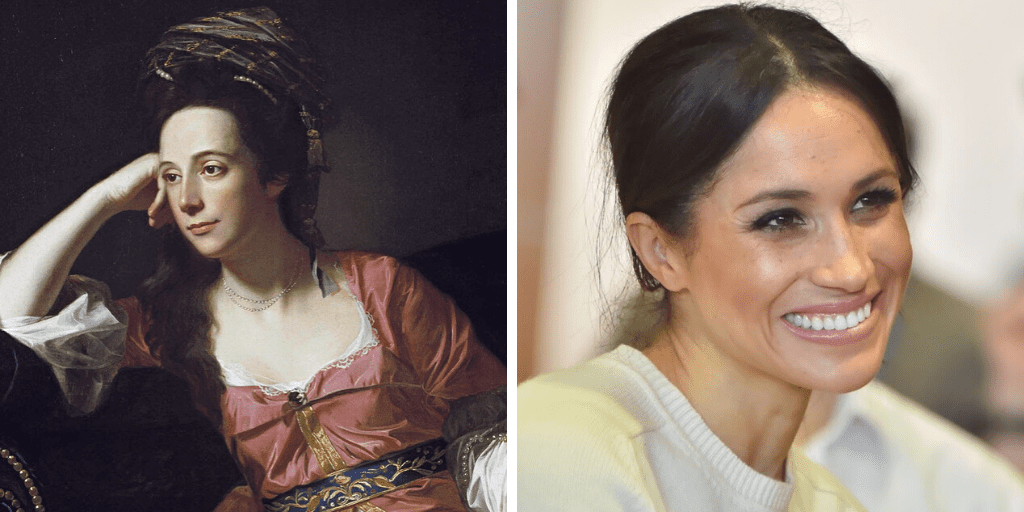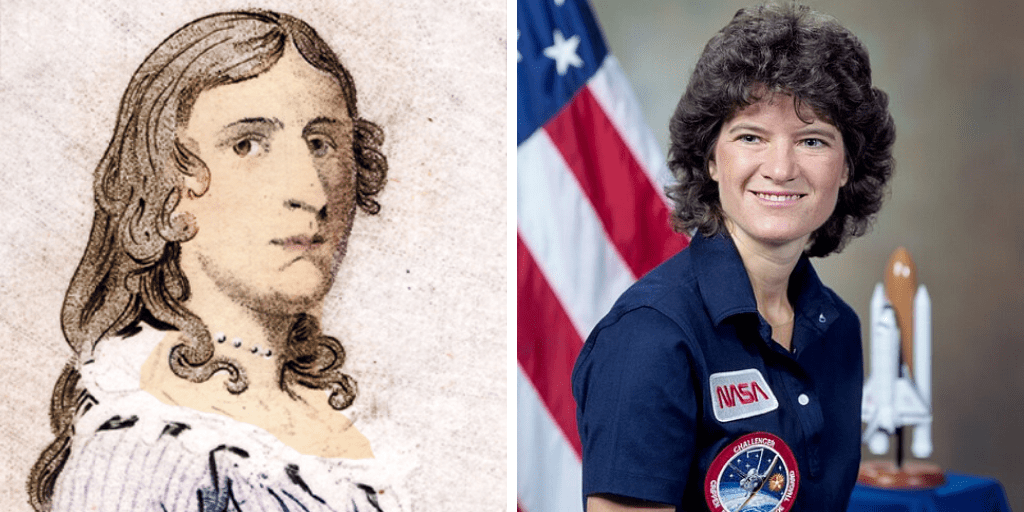
18th Century vs. Today

Margaret Kemble Gage & Meghan Markle

During the Revolution, many Colonists found their loyalties tested due to the strain between being legally and socially British citizens yet also being American colonists. This tension was felt across all social classes, and one example is the complicated position wherein Margaret Kemble Gage found herself. Born to a wealthy New Jersey family in 1734, Margaret was raised a well-to-do Colonial woman, with ties to family and social circles in New York. Her wealth afforded her a life benefited by British governance, and she soon caught the eye of visiting general, Thomas Gage. They married in 1758, proving a happy and successful union for the years prior to 1770. While sources and scholars disagree on the extent of her frustrations, it is known that Margaret had concerns for her husband and her fellow American-born citizens. In a letter regarding the bloody Battle of Bunker Hill, a quote from Shakespeare’s King John resonated with her,
“And again:
Whoever wins, on that side shall I lose,
Assured loss, before the match be played.”
At the very least, Margaret did not want to see the bloodshed continue between her British and American roots. It’s easy to imagine her heart pulled between supporting a husband she loved working for a British system that benefited her and the Colonies she grew up in. Upon the instructions of her husband, she moved permanently with their children to Britain in 1775, where she lived until she was 89. According to records, she never again visited her friends or family on American soil.
The strain between duty, love, and identity is a timeless issue, one that has been seen recently in the life of American actress Meghan Markle. Like Margaret, Meghan was born and raised in America (this time in 1981) to a fairly well-off family in Hollywood. She became an actress and model, finding success in the TV series Suits, and she eventually met and fell in love with none other than British Prince Harry, Duke of Sussex. A highly controversial marriage (unlike the Gage’s), this love match proved difficult to adjust to – Meghan was to leave America, her friends, politically active charity work, and profession, to live full time in England in the royal household. She was vilified by the media, much like Margaret, who was sullied with rumors of being unfaithful to Thomas and leaking his battle plans. However, the circumstances behind the media’s libel against Meghan was different, touching on everything from her biracial identity to over-analyzing her new royal duties. Her love for Harry put her in direct opposition to her professional and social life and something had to give. Like the Gage’s, Meghan and Harry continued their successful union in the way safest for their well being – this time, it was in North America. Reducing their status in the Royal household, they now split their time between Canada and England.
While their circumstances may be inherently different, the common theme of internal strife due to love and identity pairs Margaret and Meghan as two women navigating complicated social and personal lives in the public eye.
Deborah Sampson & Sally Ride

Deborah Sampson was a soldier in the Continental Army who disguised herself as a man and enlisted under the name Robert Shurtleff in 1782, near the end of the American Revolution. She was injured in her first skirmish but avoided detection by tending to her musket ball wounds herself. She was eventually discovered and honorably discharged. Through the rest of her life, she was a public speaker, mother, and woodworker.
Sally Ride was the first American female astronaut. Both women were revolutionary in their own times – but neither set out to be revolutionary, just to pursue their own dreams and serve their countries. While Sally Ride didn’t have to disguise herself as a man to become an astronaut, she faced a huge amount of misogyny and was the only woman among men on her first flight on the Challenger.
John Singleton Copley & Annie Leibovitz

If you think of a portrait of any famous Bostonian in the late eighteenth century, you’re probably thinking of a painting by John Singleton Copley. Born to Irish parents, most likely in Boston, Copley learned the skills of engraving and painting from his stepfather, Peter Pelham. Copley rose quickly in Boston society despite his humble beginnings by his skill and gentlemanly behavior. While he was in Boston, his subjects included John Hancock, Dorothy Quincy, Mercy Otis Warren, Samuel Adams, Joseph Warren, and many more. He left Boston in 1774 with his family and continued a very successful career in London, eventually being elected to the Royal Academy.
Annie Leibovitz, arguably the most celebrated portrait photographer of our day, has created countless iconic images of notable figures of the 20th and 21st from John Lennon to Miley Cyrus to Queen Elizabeth II. She began her career as a photographer for Rolling Stone and in 1991 became the first woman to have an exhibit at the National Portrait Gallery in London. Several of John Singleton Copley’s portraits also hang in the National Portrait Gallery.

Phillis Wheatley & Maya Angelou

Phillis Wheatley was the first published black poet in America with the publication of her book, Poems on Various Subjects, Religious and Moral. Wheatley was sold into enslavement as a very young child, captured from her home in West Africa. She proved to be a prodigy of language, learning English rapidly and devouring classical works, and began writing poetry at a young age. Her book was published in London in 1770. Her poems cover a wide variety of themes including her Christian faith, liberty, and her own enslavement. Phillis was also a regular church-goer at Old South Meeting House.
Maya Angelou was a groundbreaking black poet, memoirist, teacher, and civil rights activist whose works contain powerful messages on blackness, femininity, racism, and power. Best remembered for her memoir I Know Why the Caged Bird Sings and her poems such as “Still I Rise,” “Phenomenal Woman,” and “On the Pulse of Morning,” which she recited at the inauguration of Bill Clinton and the recording of which won her a Grammy award. She was a friend of Dr. Martin Luther King, Jr. and Malcolm X, and worked alongside them in the Civil Rights Movement.
Phillis Wheatley on freedom: From “To the Right Honourable WILLIAM, Earl of DARTMOUTH, His Majesty’s Principal Secretary of State for North-America”
“No more, America, in mournful strain
Of wrongs, and grievance unredress’d complain,
No longer shalt thou dread the iron chain,
Which wanton Tyranny with lawless hand
Had made, and with it meant t’ enslave the land.
Should you, my lord, while you peruse my song,
Wonder from whence my love of Freedom sprung,
Whence flow these wishes for the common good,
By feeling hearts alone best understood,
I, young in life, by seeming cruel fate
Was snatch’d from Afric’s fancy’d happy seat:
What pangs excruciating must molest,
What sorrows labour in my parent’s breast?
Steel’d was that soul and by no misery mov’d
That from a father seiz’d his babe belov’d:
Such, such my case. And can I then but pray
Others may never feel tyrannic sway?”
Maya Angelou on freedom: From “Caged Bird”
“A free bird leaps
on the back of the wind
and floats downstream
till the current ends
and dips his wing
in the orange sun rays
and dares to claim the sky.
But a bird that stalks
down his narrow cage
can seldom see through
his bars of rage
his wings are clipped and
his feet are tied
so he opens his throat to sing.
The caged bird sings
with a fearful trill
of things unknown
but longed for still
and his tune is heard
on the distant hill
for the caged bird
sings of freedom.”
William Billings & Chance the Rapper

William Billings is considered to have been the first American choral composer. His psalm-book, The New England Psalm-Singer, was published in 1770 – it would have been published earlier but for Billings’ insistence that it be printed only on American paper. His songs contained religion, but also politics – he was very involved in the Patriot movement and his song “Chester” became one of the most famous Patriot anthems.
Chance the Rapper, an activist and musical artist from Chicago, Illinois, is a modern example of an artist who is inspired by his faith and by the music of the church. His style and lyrics, especially in recent albums, are heavily influenced by his religion. Chance the Rapper was awarded “Outstanding Youth of the Year” in 2014 by the Mayor of Chicago for his activism. Earlier that year, his and his father’s campaign #SaveChicago resulted in 42 hours without a gun homicide in Chicago.
Chance’s similarity to William Billings’ religious and political balance is highlighted in the Pitchfork review of the Coloring Book album: “Chance the Rapper’s Coloring Book is one of the strongest rap albums released this year, an uplifting mix of spiritual and grounded that even an atheist can catch the Spirit to.”

